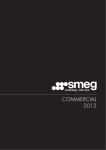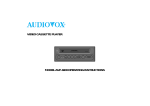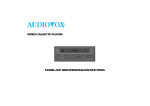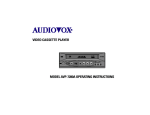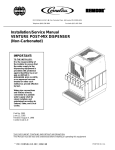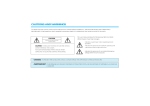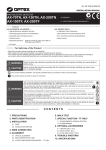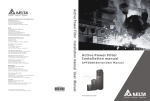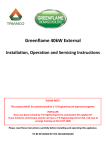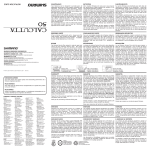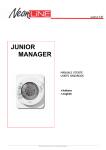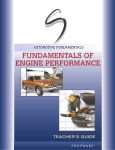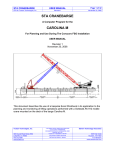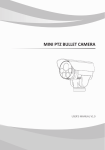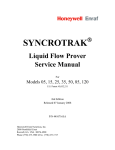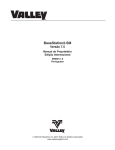Download TR-3-C 900 - SIGMA Equipment
Transcript
Operating and Service Manual TR-3-C 900 2000 PACKAGING TECHNOLOGY EN ISO 9001 70 100 M 745 EAM-MOSCA Corp. 675 Jaycee Drive • Valmont Ind. Pk. • Telephone (570) 459-3426 • Fax (570) 455-2442 TR-3-C 1- 1 CONTENTS A. INTRODUCTION 1. Introduction and Safety Procedures . . . . . . . . . . . . . . . . . . . . . . Application Principles . . . . . . . . . . . . . . . . . . . . . . . . . . . . . . . Machine Description . . . . . . . . . . . . . . . . . . . . . . . . . . . . . . . Machine and Operating Elements . . . . . . . . . . . . . . . . . . . . . General Safety Instruction . . . . . . . . . . . . . . . . . . . . . . . . . . . Safety Regulations for Specific Operational Phases . . . . . . . Precautions Against Particular Hazards . . . . . . . . . . . . . . . . . Safety Instructions . . . . . . . . . . . . . . . . . . . . . . . . . . . . . . . . . Safe Operating Principles . . . . . . . . . . . . . . . . . . . . . . . . . . . Description of Safety Arrangements . . . . . . . . . . . . . . . . . . . . TR-3-C 1- 2 TR-3-C 1-5 - 1-14 1-6 1-6 1-7 1-8 1-9 1-10 1-11 1-13 1-14 2. Operating and Technical Information . . . . . . . . . . . . . . . . . . . . . Technical Data . . . . . . . . . . . . . . . . . . . . . . . . . . . . . . . . . . . . Electrical Data . . . . . . . . . . . . . . . . . . . . . . . . . . . . . . . . . . . . Component Layout . . . . . . . . . . . . . . . . . . . . . . . . . . . . . . . . Operating and Functional Description . . . . . . . . . . . . . . . . . . Strap Spool Installing and Threading . . . . . . . . . . . . . . . . . . . Accumulator Threading, Adjustments, and Components . . . . Sequence of Operation . . . . . . . . . . . . . . . . . . . . . . . . . . . . . 2-1 - 2-14 2-2 2-3 2-4 2-6 2-9 2-10 2-12 3. Maintenance and Troubleshooting . . . . . . . . . . . . . . . . . . . . . . . Preventive Maintenance . . . . . . . . . . . . . . . . . . . . . . . . . . . . Maintenance and Lubrication . . . . . . . . . . . . . . . . . . . . . . . . . Strap Drive Adjustments . . . . . . . . . . . . . . . . . . . . . . . . . . . . Feed & Pull-Back Pressure Roller Adjustments . . . . . . . . . . . Heater Adjustments . . . . . . . . . . . . . . . . . . . . . . . . . . . . . . . . Heater Troubleshooting . . . . . . . . . . . . . . . . . . . . . . . . . . . . . Sealer Position Adjustment . . . . . . . . . . . . . . . . . . . . . . . . . . Knife Press-Bar Adjustment . . . . . . . . . . . . . . . . . . . . . . . . . . Strap Track Details for Troubleshooting . . . . . . . . . . . . . . . . . Troubleshooting List . . . . . . . . . . . . . . . . . . . . . . . . . . . . . . . . 3-1 - 3-14 3-1 3-2 3-4 3-5 3-6 3-7 3-8 3-9 3-10 3-11 4. Shipping Procedures . . . . . . . . . . . . . . . . . . . . . . . . . . . . . . . . . . Shipping Protection . . . . . . . . . . . . . . . . . . . . . . . . . . . . . . . . 4-1 - 4-2 4-1 CONTENTS • TR-3-C WHEN REQUESTING SERVICE OR REPLACEMENT PARTS Included in this manual are assembly drawings with complete replacement parts lists. When requesting service, please refer to the identification plate (detail at right) that is found on or near the electrical component box. 1. Contact EAM-MOSCA technical service department. MODEL # SERIAL # VOLTAGE 2. Give the Model #, Serial # and Year. 3. Give correct part number, found in the parts list, along with a complete description. YEAR NOTE: Electrical information and schematics are provided in the electrical enclosure box. B. PARTS IDENTIFICATION Spare Parts List . . . . . . . . . . . . . . . . . . . . . . . . . . . . . . . . . . . . . . . iii Sealer Group Assembly . . . . . . . . . . . . . . . . . . . . . . . . . . . . . . . . 3105-010000-00 2/12/1999 5-1 Sealer Knife and Gripper Bars Assembly . . . . . . . . . . . . . . . . . . 2902-010300-00 8/15/1997 5-3 Sealer Knife - Press Bar Assembly . . . . . . . . . . . . . . . . . . . . . . . 2902-010310-00 8/15/1997 5-5 Sealer Housing Assembly . . . . . . . . . . . . . . . . . . . . . . . . . . . . . . . 3105-010400-00 11/9/2000 5-7 Slide Plate Lever Assembly . . . . . . . . . . . . . . . . . . . . . . . . . . . . . 3105-010600-00 9/09/99 5-9 Sealer Feed and Pull-Back Motor Assembly . . . . . . . . . . . . . . . . 2902-010910-00 6/05/1997 5-11 Sealer Strap Tension Motor Assembly . . . . . . . . . . . . . . . . . . . . 2901-011000-00 11/5/1997 5-13 TR-3-C 1- 3 CONTENTS TR-3-C PARTS IDENTIFICATION (CONT'D) Sealer Drive Assembly . . . . . . . . . . . . . . . . . . . . . . . . . . . . . . . . . 2902-011000-00 4/01/1999 TR-3-C 1- 4 5-15 Sealer Cam Shaft Assembly . . . . . . . . . . . . . . . . . . . . . . . . . . . . . 2902-011001-00 8/18/1999 5-17 Sealer Tension-Pressure Roller Assembly . . . . . . . . . . . . . . . . . 2901-011200-00 8/29/1997 5-19 Strap Feed, Pull-Back Assembly . . . . . . . . . . . . . . . . . . . . . . . . . 2902-011200-00 7/12/1999 5-21 Sealer Feed, Pull-Back Pressure Roller Assembly . . . . . . . . . . . 2902-011300-00 5/20/99 5-23 Slide Plate Assembly . . . . . . . . . . . . . . . . . . . . . . . . . . . . . . . . . . 1620-012000-00 4/07/1997 5-25 Sealer Left Gripper Assembly . . . . . . . . . . . . . . . . . . . . . . . . . . . 0401-013000-01 8/21/1997 5-27 Sealer Right Gripper Assembly . . . . . . . . . . . . . . . . . . . . . . . . . . 0101-013000-17 8/21/1997 5-29 Heater Assembly . . . . . . . . . . . . . . . . . . . . . . . . . . . . . . . . . . . . . . 2601-015000-00 12/15/1998 5-31 Heater Assembly . . . . . . . . . . . . . . . . . . . . . . . . . . . . . . . . . . . . . . 2601-015200-00 12/15/1998 5-33 Heater Lever Assembly . . . . . . . . . . . . . . . . . . . . . . . . . . . . . . . . . 2601-017000-00 9/24/1998 5-35 Frame Assembly . . . . . . . . . . . . . . . . . . . . . . . . . . . . . . . . . . . . . . 3123-020000-00 12/10/1999 5-37 Photo Control Assembly . . . . . . . . . . . . . . . . . . . . . . . . . . . . . . . . 0601-022300-00-A 2/04/2000 5-39 Dispenser and Support Assembly . . . . . . . . . . . . . . . . . . . . . . . . 3105-030000-00 8/19/1999 5-41 CONTENTS TR-3-C PARTS IDENTIFICATION (CONT'D) Dispenser Brake with Support Assembly . . . . . . . . . . . . . . . . . . 3122-030100-00 9/03/1999 5-43 Dispenser Assembly . . . . . . . . . . . . . . . . . . . . . . . . . . . . . . . . . . . 1601-031000-00 3/02/1998 5-45 Fan Assembly . . . . . . . . . . . . . . . . . . . . . . . . . . . . . . . . . . . . . . . . 3105-050000-00 1/26/1999 5-47 Accumulator Assembly . . . . . . . . . . . . . . . . . . . . . . . . . . . . . . . . . 3105-070000-00 6/28/1999 5-49 Strap Track - Main Assembly - Rear . . . . . . . . . . . . . . . . . . . . . . 900/550 3105-080100-00-A 3/16/1999 900/900 3120-080100-00-A 5-51 Strap Track - Inner Assembly . . . . . . . . . . . . . . . . . . . . . . . . . . . . 900/550 3105-080200-00 5/18/1999 5-53 Strap Track - Main Assembly - Front . . . . . . . . . . . . . . . . . . . . . . 900/550 3105-080300-00 8/29/1997 900/900 3120-080300-00 5-55 Strap Track - Opener Assembly . . . . . . . . . . . . . . . . . . . . . . . . . . 900 3105-080700-00 4/19/1999 5-57 Strap Track - Support Frame Assembly . . . . . . . . . . . . . . . . . . . 900/550 0603-086000-00 8/27/1997 900/900 3120-080400-00 5-59 Conveyor Rollers Drive Assembly . . . . . . . . . . . . . . . . . . . . . . . . 3123-100100-00 12/10/1999 5-61 Roller Conveyor Swing Table Assembly . . . . . . . . . . . . . . . . . . . 900 3105-100200-00 1/12/1999 5-63 Roller Conveyor Assembly . . . . . . . . . . . . . . . . . . . . . . . . . . . . . . 900 3123-100300-00 12/10/1999 5-65 Transfer Roller Assembly . . . . . . . . . . . . . . . . . . . . . . . . . . . . . . . 3105-100310-00 4/01/1999 5-67 TR-3-C 1- 5 CONTENTS TR-3-C PARTS IDENTIFICATION (CONT'D) Roller Conveyor Drive Motor Assembly . . . . . . . . . . . . . . . . . . . 3105-100500-00 10/09/1997 TR-3-C 1- 6 5-69 Control Station Assembly . . . . . . . . . . . . . . . . . . . . . . . . . . . . . . . 3105-110100-00-B 2/08/2000 5-71 Electrical Enclosure Assembly . . . . . . . . . . . . . . . . . . . . . . . . . . . 3123-110300-00 11/29/1999 5-73 Double Press Assembly . . . . . . . . . . . . . . . . . . . . . . . . . . . . . . . . 900/550 3105-120000-00 10/09/1999 5-75 Guard Frame Assembly . . . . . . . . . . . . . . . . . . . . . . . . . . . . . . . . 900 3105-140000-00 8/04/1998 5-77 Accumulator Feed Pressure Roller Assembly . . . . . . . . . . . . . . 3105-200300-00 9/10/1998 5-79 Accumulator Fill Assembly . . . . . . . . . . . . . . . . . . . . . . . . . . . . . . 2902-280100-00 4/22/1999 5-81 Pneumatic Assembly . . . . . . . . . . . . . . . . . . . . . . . . . . . . . . . . . . 3105-430100-00 7/13/1999 5-83 Caster Assembly . . . . . . . . . . . . . . . . . . . . . . . . . . . . . . . . . . . . . . 3105-440400-00 12/06/1999 5-85 NOTES: TR-3-C 1- 7 INTRODUCTION & SAFETY PROCEDURES APPLICATION PRINCIPLES • A fully automatic strapping machine for nearly all bundles up to size 65"W x 18"H (1650mmW x 455mmH). • Best suited for all types of packages as in; printed material, cartons, etc. MACHINE DESCRIPTION • Fully automatic strapping machine for polypropylene strapping. • High strap tension through minimum space between conveyor and sealer. • Bundles conveyed with knurled rollers. • Conveyor speed infinitely variable. (.15 - .91m/sec 30-180ft/min) • Strap width: 5mm standard, 6-12mm optional. • Strap position is adjustable with a potentiometer. • Electronic control system PLC. • Dry contact relay for up-stream interlock. • Low wear, low friction, positive four point cam operated strap track system. • Electronic heater temperature control. • Selector switch for single or double strap. • Hinged front conveyor roller table. • Quick - strap spool exchange. • Automatic strap loop eject when bundle not in place. • Foot switch for manual cycle. • Strap tension electronically variable. • Bundle press - dual compression bars. • Automatic strap threading. TR-3-C 1- 8 INTRODUCTION & SAFETY PROCEDURES MACHINE AND OPERATING ELEMENTS 20 19 18 17 16 15 14 13 24 12 8 11 2 Control Panel Detail 25 21 24 3 4 22 7 23 6 1 5 10 9 1. 2. 3. 4. 5. 6. 7. 8. 9. 10. 11. 12. 13. 14. Machine Frame Strap Track Arch Hinged Roller Table Roller Conveyor Dispenser Cover Strap Spool Electrical Enclosure Dual Press Swivel Casters with brake, adjustable Swivel Casters, adjustable Main Switch Power-on Indicator Automatic on Illuminated Push-button Track Open/Strap Cut-Off Push-button 15. 16. 17. 18. 19. 20. 21. 22. 23. 24. 25. Manual Cycle - Push-button Selector Switch - 1. Single Strap 2. Double Strap Selector Switch - 1. With Press 2. Without Press Selector Switch - 1. Manual 2. Automatic 3. By-Pass Strap Tension - Potentiometer Strap Position - Potentiometer Safety Warning Labels - see pages 1-10 - 1-11 Foot Pedal Connection Automatic Strap Threading System E-Stops Strap Threading - Push-button TR-3-C 1- 9 INTRODUCTION & SAFETY PROCEDURES SAFETY WARNING LABELS Strap Track Detail TR-3-C 1- 10 INTRODUCTION & SAFETY PROCEDURES SAFETY WARNING LABELS (CONT'D) Press Detail TR-3-C 1- 11 INSTRUCTION & SAFETY PROCEDURES GENERAL SAFETY INSTRUCTIONS Key Rules • Before start-up, read the operating and safety instructions. • Always keep the operation instructions within easy reach at the side of the machine/system. • Observe the maintenance schedules specified or described in the operating instruc- • The machine is built in accordance with state of the art technology and the accepted rules of industrial safety. Yet, danger to life and limb of the operator or third persons, as well as damage to the machine and other resources, may still occur. • Operate this machine/system only while it is in perfect condition and in accordance with the specifications contained in this manual. • Be aware of hazards and safety issues and adhere to these operating instructions. tions. Immediately correct any malfunction that could prove detrimental to safety, or have someone else correct it. Organizational Measures • In addition to the operating instructions, observe and teach generally applicable legal and other binding regulations for the prevention of accidents and for the protection of environment. a a TR-3-C 1- 12 • All operating personnel must wear protective hair covering to contain long hair; no loose clothing or jewelry, including rings, may be worn. Injury may result from getting caught or pulled into the machinery. • Whenever necessary, or as required by regulation, use personal protective gear. • Observe all safety and warning labels on the machine. • Maintain all safety and warning labels on the machine in legible condition. • Do not let personnel with general training operate the machine/system, except under the constant supervision of an experienced operator. • Any work on electrical components of the machine/system may be performed only by qualified electrician or by trained personnel under the direction and supervision of qualified electrician and in accordance with applicable electrical codes. INTRODUCTION & SAFETY PROCEDURES SAFETY REGULATIONS FOR SPECIFIC OPERATIONAL PHASES • Refrain from any work practice that may be unsafe. • Make sure that the machine/system is operated in safe and good working order. Do not operate the machine/system, unless all protective and safety devices, such as removable machine guards, emergency shut-off switches, are in place and in working order. • At least once during each shift, you should check the machine for any external damages and defects. Any changes (including changes in performance) must promptly be reported to the competent department/person. If necessary, immediately stop and secure the machine. • In case of a malfunction, the machine/system must be stopped and secured immediately. Promptly correct the malfunction or have it corrected. • Before you put the machine/system in operation, make sure that no one is put at risk by the machine during start-up. • Inform operating personnel before you begin to perform any special or maintenance work. Designate a supervisor. • If necessary, clear and secure a space around the area where maintenance is being performed. • Always tighten any screw connections which were loosened during maintenance and repair. • Should safety devices have to be dismantled during set-up, maintenance or repairs, reassembly and inspection of the safety devices must ensue immediately after completion of such maintenance and repair work. • Provide for the safe and environmentally friendly disposal of operating and auxiliary materials, as well as spare parts. • Before moving a machine, always check that all accessories are securely stored • Discontinue any work practice that could destabilize the machine. • Keep off conveyors and/or table tops. TR-3-C 1- 13 INTRODUCTION & SAFETY PROCEDURES PRECAUTIONS AGAINST PARTICULAR HAZARDS Electric Energy • Use only original fuses with the specified amperage! If a breakdown of the electrical power supply should occur, the machine must be shut down immediately. • Work on any electrical system or equipment, may be performed only by a qualified electrician or by trained personnel under the direction and supervision of a qualified electrician and in accordance with electrical codes. • If so specified, machine and system components that are to be inspected, maintained or repaired must be switched to zero voltage. Any such disconnected components must first be examined for voltage leaks, then grounded and shorted, while adjoining voltage carrying components must be insulated. • The electrical equipment of the system/machine must be inspected/tested regularly. Defects, such as loose connections or damaged cables must be eliminated. • Should it become necessary to perform work on live components, a second person must be added to work the emergency shut-off switch or the master switch. Close off the work area with a red and white chain, and put up a warning sign. Use only insulated tools. • When working on high voltage units, disconnect from voltage, ground power supply cable and short components, such as capacitors with a grounding rod. • Carefully remount and refasten any components that were disconnected during transport before returning the machine to service. • Even minor changes in location require that the machine or the system be disconnected from each external energy source. • Before the machine is returned to operation, it must be properly reconnected to its power source. Lockout feature on Main Switch Q1 for safe work environment during maintenance. Q1 Currently in the off position. Lockout Feature Attach padlock or taglock at this point. Main Switch Detail TR-3-C 1- 14 INTRODUCTION & SAFETY PROCEDURES SAFETY INSTRUCTIONS The following list of safety instructions must be read before operating the strapping machine or the strapping system. Miscellaneous Instructions • Please observe the accident prevention regulations as well as the safety and protection recommendations of the trade or professional associations. • The machine may only be used in accordance with regulations. • If safety changes should occur in the machine/system or its performance, the machine/system must be stopped immediately and the competent person/department must be informed of the problem. Operation • Machines may only be operated by trained personnel. • Training of the customer's operating personnel is available by EAM-MOSCA customer • The hazard zone is off limits. • Keep off conveyors or table tops. • Keep all safety and hazard warnings on the machine/system in legible condition. • Do not reach into a machine that is running. • Never step into or under lifting devices. • After closing time, always shut the machine down by turning the main switch off. service. Safety Devices • Emergency-off switches must never be by-passed or deactivated. • Safety devices, not included in the delivery, such as protective grids, must be installed by the customer in coordination with the competent employer's liability insurance association. • Do not undertake any alterations, additions or modifications to the machine/system that could affect safety without authorization from the supplier. This also applies to the installation and the adjustment of safety devices and safety valves and to any machining of load-bearing parts. TR-3-C 1- 15 INTRODUCTION & SAFETY PROCEDURES SAFETY INSTRUCTIONS (CONT'D) • Do not operate the machine/system unless all protective devices and security features, such as removable protection devices and emergency-off devices are in place and functional. • If safety devices should have to be dismantled during set-up, maintenance, or repairs, reassembly and inspection of the safety devices must ensue immediately after completion of such maintenance and repair work. The following list of safety instructions must be read before operating the strapping machine or the strapping system. Repair • Before any tune-up or repair work can be performed, the machine must be disconnected from the mains and secured against unauthorized reconnection. • Tools and single components should not be placed on or in the machine. • When replacing any parts of the system, components and larger units must be carefully attached to hoisting equipment in a way that precludes any hazard. • Use only suitable and technically sound hoisting equipment as well as lifting devices with sufficient carrying capacity. • Never stand or work under suspended loads. • Components must meet the manufacturer's technical specifications. This is guaranteed when using genuine replacement parts from the manufacturer. • Hydraulic and pneumatic installations may only be worked on by personnel specifically trained and experienced in the use of hydraulics and pneumatics. Electrical Equipment • Work on any electric installations of the machine/system may only be performed by a qualified electrician or by trained personnel under the direction and supervision of a qualified electrician and in accordance with electrical codes. TR-3-C 1- 16 • Machine/system components undergoing maintenance or repairs must be disconnected from their power source and closed off. • The electrical equipment of a machine/system must be inspected/tested regularly. Defects, such as loose connections, damaged cables, and defective devices must immediately be eliminated. • If work needs to be done on live components, a second person must be added to work the emergency-off switch or the master switch. • Close off the work area with a red and white safety chain and put up a warning sign. Use insulated tools only! INTRODUCTION & SAFETY PROCEDURES SAFE OPERATING PRINCIPLES Operate this machine with polypropylene strap only. Using other strapping can cause health risk. S17 CAUTION! Risk of burn injury in heater area. • The danger points are covered by two interlocked conveyor tables. • Lifting the roller conveyor swing table 3-5mm, releases the safety interlock S17, shutting down the machine immediately. • Press will return to its up position when; the machine cycle is interrupted, a safety switch is activated, and/or if there is power loss to the machine. TR-3-C 1- 17 INTRODUCTION & SAFETY PROCEDURES DESCRIPTION OF SAFETY ARRANGEMENTS TR-3-C 1- 18 • The machine operation is stopped by any of the following: - Activating Emergency Stops S19 or S19.1. - Opening the roller conveyor swing table. - Low air pressure. • If a safety circuit is interrupted, the press returns to the up position. • The press valve Y7, is deactivated when: - The roller table is lifted. - The emergency stop is activated while the machine is cycling. • The heater is on as long as the main switch Q1 is on 1. OPERATING AND TECHNICAL INFORMATION TR-3-C 2- 1 OPERATING AND TECHNICAL INFORMATION TECHNICAL DATA Strap Weld Strap Width Strap Tension Strap Coil Strap Spool Weight Electric Power Frequency Air Supply Air Volume TR-3-C 2- 2 : : : : : : : : : : Heat Seal 9mm Infinitely variable Inner Diameter 200mm Up to 12,500ft. 375kg [825lb] 208 - 480V 50 / 60Hz 6 bar / 90 PSI 6 CFM OPERATING AND TECHNICAL INFORMATION ELECTRICAL DATA Electrical Power Line: Power output: Load Amperage: Voltage: Frenquency: Current type: 3L + GND 2.1 kW 7.0 Amp. at 220 V. 208 - 480 V. 50 / 60 Hz 3 Ph. Electrical Power Requirement • The supply line for the machine must be a minimum 4 wire. 1.5mm2 (14AWG). • The line protection fuse shall be not more than 15 Amp. • The line connector shall be a grounded 4 pole. • The machine shall be operated only in a dry environment. TR-3-C 2- 3 OPERATING AND TECHNICAL INFORMATION COMPONENT LAYOUT S19 Control Panel B15 S20 B13 B13.1 B11 S19.1 M5 M3 B1 S17 E1/R1 M6 M8 M4 M2 St M1 T1 B8 Y7 Y9 Y4 B7 Page 1 of 2 TR-3-C 2- 4 OPERATING AND TECHNICAL INFORMATION COMPONENT LAYOUT B1 B7 B8 B11 B13.1 B13 B15 E1/R1 H12 M1 M2 M3 M4 M5 M6 M8 Q1 R10 R20 S1/H1 S2 S3 S4 S10 S17 S19 S19.1 S20 S80 St T1 Y4 Y7 Y9 R10 Proximity Sensor - Strap In Sealer Proximity Sensor - Strap Supply Proximity Sensor - Accumulator Fill Proximity Sensor - Strap Track Closed Proximity Sensor - Sealer Position Proximity Sensor - Sealer Home Position Photo Control - Conveyor Stop Heater Automatic On - IIluminated Push-button Accumulator Fill Motor Conveyor Motor Strap Tension Motor Sealer Motor Strap Feed - Pull-Back Motor Exhaust Fan Motor Fan Main Switch Strap Position - Potentiometer Strap Tension - Potentiometer Power On - Indicator Selector Switch - 1. Manual 2. Automatic 3. By-Pass Selector Switch - 1. Press Off 2. Press On Selector Switch - 1. Single 2. Double Push-button - Manual Cycle Safety Switch - Roller Table Closed Emergency Stop Emergency Stop Push-button - Strap Threading Push-button - Track Open/Strap Cut-Off Electrical Enclosure Transformer Dispenser Brake Solenoid Valve - Press Solenoid - Auto Thread Gate R20 S2 S3 S4 S10 S80 S75/H12 S1/H1 Control Panel Detail Q1 Page 2 of 2 TR-3-C 2- 5 OPERATING AND TECHNICAL INFORMATION OPERATING AND FUNCTIONAL DESCRIPTION S19 Control Panel See Detail Page 2.5 B15 S20 B13 B13.1 S19.1 B11 M5 M3 B1 S17 E1/R1 M6 M8 M4 M2 M1 St T1 B8 Y7 Y9 Y4 B7 1. Before connecting machine to a 3-Phase system, make sure machine is set to proper voltage. Transformer (T1) primary can be connected for 220V, 260V, 400V, 440V, 500V 530V (+/- 20V) i.e. 480V => 500V – 20V. NOTE: Make sure only 24V DC is connected to interfaceinput. Example: If machine is connected to a 480V outlet, (T1) should be set with 1 line to 500V and the other line to – 20 V. 2. Connect machine and turn main switch (Q1) on. Power On Indicator (H1) will flash until pressed. and NOTE: If machine is in by-pass mode, the conveyor will start immediately, when automatic on push button (S75/H12) is pressed. 3. TR-3-C 2- 6 Install the strap spool and thread the strap as indicated in the threading diagram. (see page 2.8-2.9) OPERATING AND TECHNICAL INFORMATION OPERATING AND FUNCTIONAL DESCRIPTION (CONT'D) 4. Push automatic on push button (S75) and Strap Threading Push-button (S20): Solenoid (Y9) energizes, the threading gate moves up into position, accumulator fill motor strap drive motor (M5) start. Strap is fed automatically up into the strap drive and the sealing unit into the track. Timer 13 times out and strap drive motor (M5) stops solenoid (Y9) de-energizes; the threading gate drops back down into open posiaccumulator fill motor (M2) continues to run until sensor (B8) activates indicating accumulator is full of strap. 5. Strap drive motor (M5) starts and feeds strap around the track until sensor (B1) activates, indicating strap is in the sealing unit. Strap drive motor (M5) stops and automatic on indicator (H10) activates. (M2) and through and tion. The that the NOTE: If machine is in automatic mode, the conveyor will start immediately, when automatic on push button (S75) is pressed. 6. After approximately one minute, the heater will reach weld temperature, and the machine will be ready for strapping. 7. If automatic mode is not already selected, use selector switch (S2) to choose automatic mode. The conveyor will start and is now ready for automatic operation. 8. The incoming bundle activates photo control (B15) and is conveyed into position as indicated by strap position potentiometer (R10). If selected, the press comes down to compact the bundle. The sealer motor (M4) activates opening the track and turning the sealer into pull-back position. 9. Strap drive motor (M5) starts and the strap is pulled back down into the accumulator and around the bundle. 10. When pull back is completed as indicated by Timer 3, sealer motor (M4) starts turning the sealer into tension position. Final strap tension is applied as indicated by strap tension potentiometer (R20). 11. When tension is complete as indicated by motor control (N3), sealer motor (M4) is activated turning the sealer into weld cooling position. 12. When weld cooling is complete as indicated by Timer 22. Sealer motor (M4) activates and returns the sealer to the home position. 13. The conveyor starts up, the bundle exits from the machine and strap drive motor (M5) feeds the strap around the track for the next cycle. NOTE: Refer to pages 2.5 - 2.6 for the Component Layout. TR-3-C 2- 7 TR-3-C 2- 8 Accumulator sensor flag fill position. Threading Gate in open position. Accumulator sensor flag full position. Threading Gate in feed position. M J N G Insert (4) NT 12 or (3) NT 822 washers for proper feed pressure roller tension. ACCUMULATOR ADJUSTMENTS, AND COMPONENTS STRAP SPOOL INSTALLING AND THREADING E F Feed Pressure Roller Tension Detail K H D B A C OPERATING AND TECHNICAL INFORMATION 9. 6. 7. 8. 1. 2. 3. 4. 5. Turn knob (A) counterclockwise, and remove dispenser cover (B). Place the strap spool on the dispenser and make sure that it unwinds in the counterclockwise direction. Replace the dispenser cover (B) and tighten knob (A). Remove all tape and straps from the strap spool. Push about 20cm (8 inches) of strap through guide (C) over roller (D), and into the strap guide opening until you feel a resistance. Push down lever (H) and feed more strap between rollers (E) and (F). Release the lever. Push the "Automatic On" push button S75 and S20 Strap Threading Push-button on the control panel, the threading gate (G) will close. The strap will be threaded automatically into the machine. STRAP SPOOL INSTALLING AND THREADING A - Dispenser Knob B - Dispenser Cover C - Strap Guide D - Strap Guide Roller E - Accumulator Fill Drive Roller F - Pressure Roller G - Threading Gate H - Threading Lever J - Threading Gate Solenoid K - Strap Proximity Sensor M - Accumulator Fill Proximity Sensor N - Threading Gate Return Spring ACCUMULATOR , ADJUSTMENTS, AND COMPONENTS OPERATING AND TECHNICAL INFORMATION TR-3-C 2- 9 OPERATING AND TECHNICAL INFORMATION SEQUENCE OF OPERATION TR-3-C 2- 10 1. The strap is fed out of the accumulator, into the sealer. (Illuminated push button H12 on) 2. After the photo control signals the sealer to start, the right gripper clamps the strap end. 3. The strap track is opened and the strap is pulled around the bundle. 4. When the strap tension is reached the sealer starts again to grip the other end of the strap with the left clamp. The sealer continues and cuts the other strap end and the heater moves in between the two strap ends, melting each surface. 5. After the heater moves out, the center knife-press bar moves up to squeeze the molten surfaces of the strap together. 6. The sealer motor M4 stops momentarily, in cooling position, until weld cooling timer, times out. 7. At the end of the cooling cycle, the slide plate moves out to release the welded strap, and the strap track closes, which ends the strap cycle. This signals the strap to feed through the strap track into the sealer. (The strap ready indicator H12 turns on) MAINTENANCE AND TROUBLESHOOTING PREVENTIVE MAINTENANCE 1. Check all electrical plug-connections. 2. Clean the exhaust fan periodically. 3. Reseat the plug-in relays. 4. Check the proximity sensor mounting gap, and clean when needed. 5. Check the temperature control setting. The temperature of the heater is measured on the heater tongue and should read 260º C (500ºF). If needed, adjust the temperature with the potentiometer on the controller N1 (found in the electrical enclosure). 6. Check all screws every 6 months and tighten when necessary. 7. Keep the inside of the machine clean in order to see possible damage to cables or sensors. 8. Clean out the inner strap track area periodically and lubricate the linkages with light oil. 9. Make sure to clean and lubricate the sealer regularly as per instruction. (See page 3-2) 10. Work on the electrical control system must only be done by qualified personnel. TR-3-C 3 - 1 MAINTENANCE AND TROUBLESHOOTING MAINTENANCE AND LUBRICATION • Lubricate at noted areas weekly with small doses. • Use only, light-clear oil. • All other assemblies are lubricated for life. • Keep the strapping machine, especially the strap guides and sealer in clean condition. TR-3-C 3 - 2 MAINTENANCE AND TROUBLESHOOTING MAINTENANCE AND LUBRICATION Maintenance • With timely and careful maintenance the strapping machine is kept in optimum operating condition. • Keep the strap drive and sealer clean and free of paper, dust and strap pieces. • Clean out the following with a brush or blow out with air weekly; - The Accumulator and Accumulator Fill Drive . - The Strap Guides. (upper, lower, and bridge area) - The Conveyor. - The Heater. - The Gripper Areas. - The Inner Strap Track. • On the pneumatic system check the following daily. - Close the slide-shut-off valve and check that the press will fall down to 1" above the conveyor rollers. Lubrication • The sealer gripper and slide plates should be lubricated weekly with light, clear, non-gumming oil. (3 in 1 oil recommended) are • For machines equipped with a Bosch pneumatic oiler use Bosch No. 1 829 990 046 - 1 oil or equivalent type HL 25 DIN 51524-ISO VG 32. • Most machines built after July of 1998 are equipped with pneumatic cylinders and valves that lubricated for life. MAINTENANCE INSTRUCTIONS 1. The temperature of the heater is measured on the heater tongue and should read 260°C or 500°F. Adjustment is made with the potentiometer on temperature control N1. 2. The exhaust fan must be cleared periodically. 3. Check the proximity sensors and photo controls for proper mounting and adjustment. 4. Keep the inside of the machine clean and look for possible damage to cables and switches. 5. Make sure only properly trained personnel (Electrician) will work on the control system. TR-3-C 3 - 3 MAINTENANCE AND TROUBLESHOOTING STRAP DRIVE ADJUSTMENTS 15 13* *see note below for These adjustments shown are when the sealer is in the home position. The spring adjustments the tension pressure roller, are shown for 5mm strap through 13mm strap width. *NOTE: For thick and wide strap (0.7mm and thicker) adjust to 12mm TR-3-C 3 - 4 MAINTENANCE AND TROUBLESHOOTING FEED AND PULL-BACK PRESSURE ROLLER ADJUSTMENTS A B D E • The following adjusments are made to create necessary pressure for rollers (A) and (B) not to slip on the strap. • If more pressure is required for rollers (A) and (B): first increase spring tension (D), loosen jam nut (E) and turn clockwise a few flats or until the proper pressure is achieved. TR-3-C 3 - 5 MAINTENANCE AND TROUBLESHOOTING HEATER ADJUSTMENTS Detail 1 Heater 1/16" clearance Top Plate 1/32" clearance Lower Plate Left Clamp Right Gripper Knife Heater Tongue Top Plate 24V. Heater 1/16" or within clearance Detail 2 Screw is welded or pined to mounting plate. Mounting Plate Spring Hex Nuts NOTES: 1. 2. 3. 4. 5. 6. 7. 8. 9. 10. In order to adjust the heater to the above shown clearances: Turn the machine power off. Turn the sealer motor (M4) using the hand wheel to bring the heater into the weld area. Remove the spring. Loosen the hex nuts in the mounting plate. Move the heater into the correct position according to details 1 & 2 and tighten the top nut. Turn the sealer motor (M4) to bring the heater out. Tighten both “hex nuts” firmly.` Replace the spring. Make sure to check adjustment after tightening the “hex nuts”. Make sure to secure the wires properly. They should not contact the cover plate when in maximum up position. TR-3-C 3 - 6 MAINTENANCE AND TROUBLESHOOTING 24V DC HEATER TROUBLESHOOTING 24V. Heater * NOTE: MAKE SURE ALL CONNECTIONS OF THE TEMPERATURE SENSOR ARE 100% TIGHT. ANY RESISTANCE AT THE TERMINALS WILL REDUCE THE TEMPERATURE OF THE HEATER. CONTROLLER TERMINALS: 1. Temperature Sensor White (-) 2. Temperature Sensor Green (+) 4. Heater Element Blue 5. Heater Element Brown 3. +24 V DC 6. 0 V DC (Ground) 7. Relay Output: 3A max. 8. Relay Output: 3A max. OHMS READINGS: (Make sure to unplug from the controller.) Heater Element: 8 Ohm +/- 1 Ohm, 72W. *Thermocouple Sensor voltage: 0-12 mV. Sensor: about 4-5 ohms @ room temperature. Sensor 40 ohms @ operating temperature. Check sensor and heater wires to ground. LED INDICATORS ON CONTROLLER: Red: Trouble or temperature setting not reached. Green: Heater on - when temperature is reached, begins blinking. NOTE: Proper polarity must be observed when measureing the sensor. The plug must be removed to check the heater element. The sensor voltage can be checked with the plug on or off and even with the power on. Make sure the wires are tied to the terminal block with a high temperature cable tie. PART NUMBERS: Heater Complete - Standard and Standard II Sealer: 2601-0150-00 Heater Tongue - Standard and Standard II Sealer: 2601-0150-09 Controller: ME 1884A02 TR-3-C 3 - 7 MAINTENANCE AND TROUBLESHOOTING SEALER POSITION ADJUSTMENT Note: Sealer moves counterclockwise through positions 1-3, looking at the sealer from the left side. Flag 3 Flag 3 Flag 2 B 13.1 B 13.1 Flag 2 Track Cam B 13 Flag 1 Flag 1 B 13 1. Home Position Sealer stops after Flag 1 activates and deactivates sensor B13.1. Sensor B13 remains activated. 2. Pull-back Position Sealer stops after Flag 2 activates and deactivates sensor B13.1. B13 is not activated. Flag 1 Flag 2 Flag 3 B 13.1 B 13.1 Flag 3 Flag 2 Flag 1 B13 3.1. Tension position Sealer stops after Flag 3 activates and deactivates sensor B13.1. B13 is not activated. 3.2. Weld cooling position After the internal timer times out, the sealer pauses in weld cooling position. TR-3-C 3 - 8 B 13 4. Track open - (strap cut-off) The sealer moves reverse, clockwise from the home position until sensors B 13 and B13.1 are deactivated. MAINTENANCE AND TROUBLESHOOTING KNIFE PRESS-BAR ADJUSTMENT Top Plate Right Gripper Left Gripper Knife Cutting Edge Knife-Press Bar To Align knife edge against the Right Gripper: 1. Turn the sealer in reverse, to manually lift the knife-press bar to align both cutting edges. 2. Loosen the knife screw, then tighten the screw while pressing the knife against the right gripper. Make sure the screw top is flush with the top of the knife. TR-3-C 3 - 9 MAINTENANCE AND TROUBLESHOOTING STRAP TRACK DETAILS FOR TROUBLESHOOTING B L J C C X A Detail 1 Upper Strap Guide Detail Detail 2 Open Strap Track D J X K E C I H E A D F G Detail 3 Closed strap Track TR-3-C 3 - 10 F G Detail 4 Feed pull-back pressure roller assembly (A), and tension roller assembly (G) removed. MAINTENANCE AND TROUBLESHOOTING TROUBLESHOOTING LIST Trouble Cause Remedy Strap not feeding into the strap track. Strap jammed in the strap track. 1. Turn main switch (Q1) off. 2. Open the conveyor swing table. 3. Swing the feed pull-back pressure roller assembly (A) open by unhooking spring lever (B). This allows the feed pull-back pressure roller assembly to relieve pressure on the feed wheel. 4. Turn the feed wheel (C) counterclockwise with your left hand, while holding the strap (X) down with your finger from your right hand creating a loop. 5. Use the loop to pull any jammed strap out of the sealer and top guide. 6. After all jams are cleared, cut the strap and re-thread into the machine. (See details page 3-10) Foreign particles like tape, strap pieces or dust build-up are in the way of the strap. 1. Turn the main switch (Q1) off. 2. Open the conveyor swing table. 3. Swing the feed pull-back pressure roller assembly open, by unhooking spring lever (B), allowing the feed pull-back pressure roller assembly to relieve pressure on the feed wheel. (C) 4. Unhook the safety clip (D) and pull out bolt (E). (Detail 3 pg. 3-10) 5. Remove rocker arm (F). 6. Remove tension pressure roller assembly (G) allowing access to the lower strap guide (H). 7. With the strap track open, remove the two hex screws (L) on top of strap guide (J), and pull out the cover plate. 8. Clean the guide, making sure to remove all dirt and strap deposits. 9. Remove the two bolts (K) of the lower strap guide (H) and remove the guide. 10. Remove the two cover screws, the cover and clean the guide. (See details page 3-10) Strap Sensor (B1) Finger or pin is caked with strap dust. Remove all dust and debris. Make sure the pin and strap sensor finger move freely. Check sensor B1 for the proper adjustment or if it is defective. Refer to page 3-10 for details TR-3-C 3 - 11 MAINTENANCE AND TROUBLESHOOTING TROUBLESHOOTING LIST (CONT'D) Trouble Cause Remedy Strap does not feed around the track. Upper strap guide and/or strap track infeed guides are blocked, loose, or incorrectly adjusted. Clean all debris from upper strap guide. Make sure guide is properly aligned and tightened. Strap track or slide plate not fully closed. Sensor B11 is not activated. Make sure the strap track & slide plate are fully closed. Check proximity sensor B11 at input E03. Make sure that the sensor is not damaged or misadjusted. Adjust the sensor bracket to have the light off when the strap track is open approx. 1/8" & the slide plates are fully closed. Strap track is blocked. Clean all debris from strap track. Strap track is spaced incorrectly from track frame, spitting the strap out during the strap feeding. Make sure to align the inner strap track to the track frame so there is no gap when the track is in its full closed position. Use alignment screws. Strap sensor B1 not adjusted properly, or is defective. Check cables and adjustment. Check input E00. Adjust the strap sensor B1 to have light "on" when the strap sensor flag (1) is pushed toward the sensor, 2/3 of total travel distance. (See page 3-8) Strap feed, pull-back motor or cables bad or defective. Check cables for damage. Check output A20. Sealer not in home position. Make sure the right gripper is in the down position. Reference position to the timing mark. Check the spring. A gripper is sticking, not following the cam. A gripper in the up position does not allow the strap to feed. Clean all debris from grippers. Check gripper springs, and lubricate all grippers with light oil regularly. Strap feed, pull-back motor or cables bad or defective. Check cables for damage. Check output A21 Strap jammed in upper or lower strap guide. Clean all debris from guides. Make sure the strap does not bind when being moved through guides. Strap does not pull-back when sealer cycle starts. TR-3-C 3 - 12 MAINTENANCE AND TROUBLESHOOTING TROUBLESHOOTING LIST (CONT'D) Slide Plate Sealer Rear View Strap Sensor Actuator StrapB1 Track B11 Trouble Cause Remedy Strap does not feed into sealer. Feed motor tries to feed, with strap in the accumulator. Threading gate does not close. Accumulator fill switch may be stuck down, simulating the accumulator is full of strap. Check if B7 strap end sensor flag is stuck. Make sure all debris is cleared from the accumulator drive and switch area. Feed motor pressure roller assembly not providing enough pressure, or roller doesn't spin freely. Clean all debris from roller assembly. Make sure that the spring is properly connected. Lower strap guide is blocked or incorrectly adjusted. Clean all debris from guide. Make sure that the lower strap guide, strap opening is aligned with the accumulator exit opening. Strap is stuck on the dispenser, wedged into the side. Make sure the strap coil is in good shape and there are no gaps between the coil and the cardboard dispenser discs. Accumulator fill strap guide is blocked or incorrectly adjusted. Clean all debris from guide. Adjust so guide opening is aligned with lower strap guide opening. Make sure all screws are tight. Dispenser brake or connection is bad or defective. Check output A08. It must be on to release the brake when filling the accumulator. Strap does not feed into the sealer. Feed motor tries to feed. No strap is in the accumulator. Lower strap guide is loose or tension Make sure guide is tight and is roller and/or tension pressure roller is properly aligned. The tension and touching the guide. tension pressure roller should not be touching the guide. TR-3-C 3 - 13 MAINTENANCE AND TROUBLESHOOTING TROUBLESHOOTING LIST (CONT'D) Trouble Cause Remedy Strap does not feed into the sealer. Motor is not turning. Strap track or slide plate are open. Proximity sensor B11 is not activated. Check input E03. Make sure sensor flag on slide plate is adjusted correctly, and the strap track is closed. Strap feed sensor B1 is not properly adjusted or it is defective. Strap is pulled back past the tension roller. Clean the sensor flag area. Check input E00. Feed motor connection is bad, or motor is bad. Check cable and connections. Check output A20. Slide plate gib is loose allowing the slide plate to move up when right gripper moves up. Align the slide plate and tighten both left and right gibs. Make sure slide plate moves freely. The two ribs on the bottom of the slide plate are worn or damaged. Replace the upper portion of the slide plate; part number (5-6mm strap - 0401-0120-01), or (7-12mm strap - 0101-0120-01). Upper slide plate is cracked or damaged. Check slide plate for damage and cracks. Replace the upper portion of the slide plate; part number (5-6mm strap - 0401-0120-01) or (7-12mm strap - 0101-0120-01) Clean all debris from sealer grippers area. Right gripper does not move up enough to grip the strap to the slide plate. Check the head of the right gripper. Make sure that it is not damaged. Check that the internal spring of the right gripper is not damaged. Check the right gripper cam and cam follower for damage. Early signal to B1 sensor is causing the strap to stop short of the sealer area. No strap for the right gripper to clamp. Check sensor B1 for the proper adjustment or if it is defective. Heater controller is bad or defective Check input E19. Proper machine operation not selected. Check if desired machine operation is selected on the control panel. Sealer motor or connection bad. Check cables and connections. Check input A19. Strap pulls out of sealer during the pull-back and/or tension cycle. Strap cycle will not start. TR-3-C 3 - 14 MAINTENANCE AND TROUBLESHOOTING TROUBLESHOOTING LIST (CONT'D) Trouble Cause Remedy During sealer cycle, the strap weld pops apart. Exhaust fan is replaced and installed reverse. Air flow from the exhaust fan is in the wrong direction. Air should blow away from the heater. Heater temperature is set too high or too low. Set the heater temperature with controller N1. The temperature for the heater should be 260ºC (500ºF) at the tip of the heater tongue. The heater is misaligned. The heater should be adjusted according to the "Heater Adjustments" section in this manual. (see page 3-6 & 3-7)) Screw on knife-gripper is not flush with the knife head. Adequate and even pressure is not being obtained. Grind flush, but do not grind the top of the knife-gripper head. (see page 3-9) Slide plate is cracked Adequate pressure is not obtained between the grippers and upper slide plate. Replace the upper slide plate. (5-6mm strap 0401-012000-01 or 7-12mm strap 0101-012000-01) Conveyor motor, cable, or connection bad. C heck all cables and connections. Make sure all connections are proper, and that no cables are damaged. Controller terminals or output do not have the correct voltages. Check output A22 & verify 24V DC. Fuse blown, or not seated correctly. Check fuse F3. Make sure the fuse is seated correclty in fuse holder. If fuse is blown, replace with 6.3A. fuse. Downstream equipment i s faulted or jumper is loose or disconnected. Check input E23. Machine is in manual mode. Set machine to operate automatic or bypass. Conveyor doesn't start. TR-3-C 3 - 15 MAINTENANCE AND TROUBLESHOOTING TROUBLESHOOTING LIST (CONT'D) Trouble Cause Remedy Machine does not seem to tension or tensions sporadically. Tension pressure roller arm does not move freely. Spring lever out of adjustment. Pressure roller lever is binding on pivot shaft. Clean all debris from pressure roller area. Make sure there is adequate spacing behind the lever on the pivot shaft. Tension roller or tension pressure roller is hitting against the lower strap guide. Adjust lower strap guide so both rollers are free in neutral and tension position. Tension motor cable connection bad, or cable damaged. Motor is defective. Check cables for damage. Check output A18. Strap does not pull back when sealer cycle starts, but makes a complete weld. Strap feeding too hard causing a kink in the strap, not allowing the strap to be pulled back. Check pressure on feed spring of rocker. See detail page 3-5. Sealer is not in home position. Sensor flag is out of adjustment, or sensor is defective. Check proximity sensor B13 & B13.1. Check inputs E04 & E05. Make sure the sensor flags are in their proper position. (see page 3-8) **For further help, please call the EAM-MOSCA service department.** TR-3-C 3 - 16 SHIPPING PROCEDURE SHIPPING PROTECTION A Lift strap load capacity shall be 500kg min each. Center of Gravity B • The strapping machine is shipped on a pallet. With lift straps (A), it is lifted on to the pallet. • With straps (B), the machine is fastened to the pallet to prevent sliding. Use Caution when cutting these straps. Use proper eye protection when cutting. • Lift straps shall be used to lift the machine off the pallet. CAUTION: Care should be taken when cutting or disposing of metal strapping. Wear proper clothing including gloves and safety glasses. Dispose of loose strapping immediately. TR-3-C 4- 1 PARTS IDENTIFICATION TR-3-C 4- 2















































